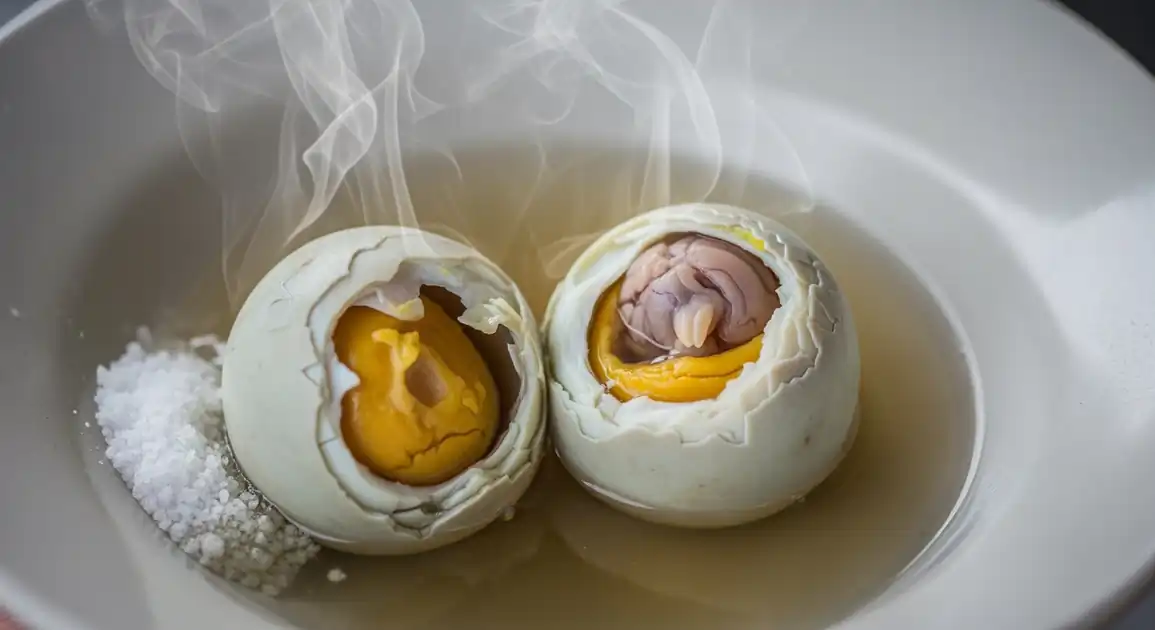Balut (Fertilized Duck Egg)
Balut

Description
Manila, as the bustling capital, offers countless opportunities to find Balut. Vendors are ubiquitous, especially in the evenings, navigating residential areas, busy street corners, and near transport hubs throughout Metro Manila. Expect high availability and the classic Balut experience.
Dietary Information
Serving information
Serving style
Classic street style: warm egg, salt, spiced vinegar, eaten by hand.
Quick facts
Typically 6 PM - 2 AM, sometimes later in nightlife areas.
Safety Tips
What to Look For
-
Egg feels distinctly warm or hot to touch
Indicates recent cooking and helps ensure pathogens are killed. Cold balut is riskier.
-
Vendor keeps eggs in an insulated container (e.g., cloth-lined basket, styrofoam box)
Helps maintain the crucial warm temperature for safety and quality.
-
Intact, uncracked shell before purchase
Cracks can allow bacteria to enter after cooking. Minor cracks during handling are different.
-
Clean condiment dispensers (salt shaker, vinegar bottle)
Reflects general hygiene practices of the vendor.
-
Vendor has regular local customers
Often indicates reliability and trusted quality within the community.
What to avoid
-
Cold or room temperature Balut
Higher risk of bacterial growth. Balut must be served warm/hot.
-
Eggs with significant cracks before buying
Potential entry point for contaminants after cooking.
-
Visibly dirty vendor setup or handling practices
Poor hygiene increases the risk of contamination.
-
Balut sold in questionable locations or by unknown vendors
Stick to vendors in busy areas or those recommended by locals if possible.
Price information
Price range
Budget tips
- Prices might be slightly higher in central business districts (Makati, BGC) compared to residential areas (e.g., Quezon City, Pasay).
- Street vendors offer the standard price; restaurants mark up significantly.
- Look for vendors where locals are buying.
Value indicators
- Served hot/warm.
- Reputable vendor appearance.
- Standard size egg for the price.
Where to Find This Dish
Residential Neighborhoods (e.g., Quezon City, Sampaloc)
Vendors walk routes calling out 'Balut'. High chance of finding them here.
Local streets, Small community stores ('sari-sari')
7 PM - 11 PM
University Belts (e.g., near UST, UP Diliman)
Catering to students and residents in surrounding areas.
University campuses, Nearby eateries
Evening, Night
Busy Intersections / Transport Stops
High foot traffic areas often attract vendors.
Jeepney/bus stops, LRT/MRT station surroundings
Evening, Night
Makati / BGC (near nightlife)
Vendors may appear later in the evening catering to crowds leaving bars/restaurants.
Poblacion (Makati), Bonifacio High Street vicinity (BGC)
Late Night (10 PM onwards)
Vendor Tips
- Be ready with small bills/coins.
- Confirm the price before agreeing ('Magkano po?').
- If unsure, observe where locals are buying from.
- Vendors are mobile, so walk around likely areas if you don't see one immediately.
How to Order
Regional Variations
-
Vinegar Spice Level
(Anghang ng Suka)
Vinegar spiciness might vary; some vendors offer milder or spicier options if asked.
-
Availability of Penoy
(Penoy)
Most Balut vendors in Manila will also sell Penoy.
Cultural context
History
While the exact origins are debated, with potential influences from Chinese traders ('Maodan'), Balut has become intrinsically Filipino. It gained popularity as an affordable, protein-rich snack, especially sold by night vendors. It's culturally regarded by some as an aphrodisiac and energy booster. Today, it remains a ubiquitous street food and a symbol of Filipino culinary identity, often presented as a challenge to adventurous visitors.
Local significance
Strongly reflects the national significance. A very common sight and sound in Manila's evenings. Integral part of the urban street food scene.
Eating customs
- Standard Filipino way: Sip broth, season, eat contents.
- Consumed quickly and informally.